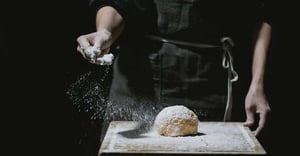Unlock the secret to creating a delightful, homemade olive tapenade with this easy-to-follow recipe...
How to Make Delicious Olive Ciabatta at Home
Unlock the secrets to baking the perfect olive ciabatta right in your kitchen with our easy-to-follow guide.
Click on the audio link above for instant listening gratification!

Exploring the Origins of Ciabatta and Its Variations
Ciabatta, a classic Italian bread, was first created in 1982 by a baker in Verona. The bread's name means 'slipper' in Italian, a nod to its unique shape. Unlike traditional Italian breads, ciabatta has a higher hydration level, giving it a soft, airy interior and a crisp crust.
Over the years, ciabatta has evolved into various forms, including ciabatta al latte (made with milk) and ciabatta integral (whole wheat). The addition of olives to ciabatta dough introduces a burst of Mediterranean flavor, making it a delightful variation.
Essential Ingredients for Your Olive Ciabatta
To make olive ciabatta, you'll need the following ingredients: 500g bread flour, 10g salt, 10g sugar, 10g instant yeast, 350ml warm water, 50ml olive oil, and 100g pitted black olives.
It's important to use high-quality bread flour and fresh olives to achieve the best flavor and texture. The olive oil not only adds richness but also helps in achieving a tender crumb.
Step-by-Step Guide to Making Olive Ciabatta
1. In a large bowl, combine the flour, salt, sugar, and yeast. Gradually add the warm water and olive oil, mixing until a shaggy dough forms.
2. Knead the dough on a floured surface for about 10 minutes until smooth and elastic. Incorporate the olives during the last few minutes of kneading.
3. Place the dough in a lightly oiled bowl, cover with a damp cloth, and let it rise in a warm place for 1-2 hours, or until doubled in size.
4. Preheat your oven to 220°C (428°F). Punch down the dough and divide it into two portions. Shape each portion into a long, flat loaf, and place them on a baking sheet lined with parchment paper.
5. Bake for 25-30 minutes, or until the loaves are golden brown and sound hollow when tapped. Let them cool on a wire rack before slicing.
Tips and Tricks for the Perfect Ciabatta Texture
Achieving the perfect ciabatta texture involves a few key techniques. First, ensure your dough is well-hydrated; it should be sticky but manageable. Using a high hydration dough results in the characteristic open crumb structure.
Secondly, avoid over-handling the dough during shaping to preserve the air pockets formed during fermentation. Lastly, bake with steam by placing a tray of water at the bottom of the oven, which helps in developing a crispy crust.
Creative Serving Suggestions for Olive Ciabatta
Olive ciabatta is versatile and can be enjoyed in many ways. Serve it warm with a drizzle of extra virgin olive oil and a sprinkle of sea salt for a simple appetizer.
For a more hearty meal, use olive ciabatta to make gourmet sandwiches with fillings like roasted vegetables, mozzarella, and pesto. It also pairs wonderfully with soups and stews, adding a touch of Mediterranean flair to your meals.
Join our mailing list by filling in the form below to get the latest news, recipes and product updates!
